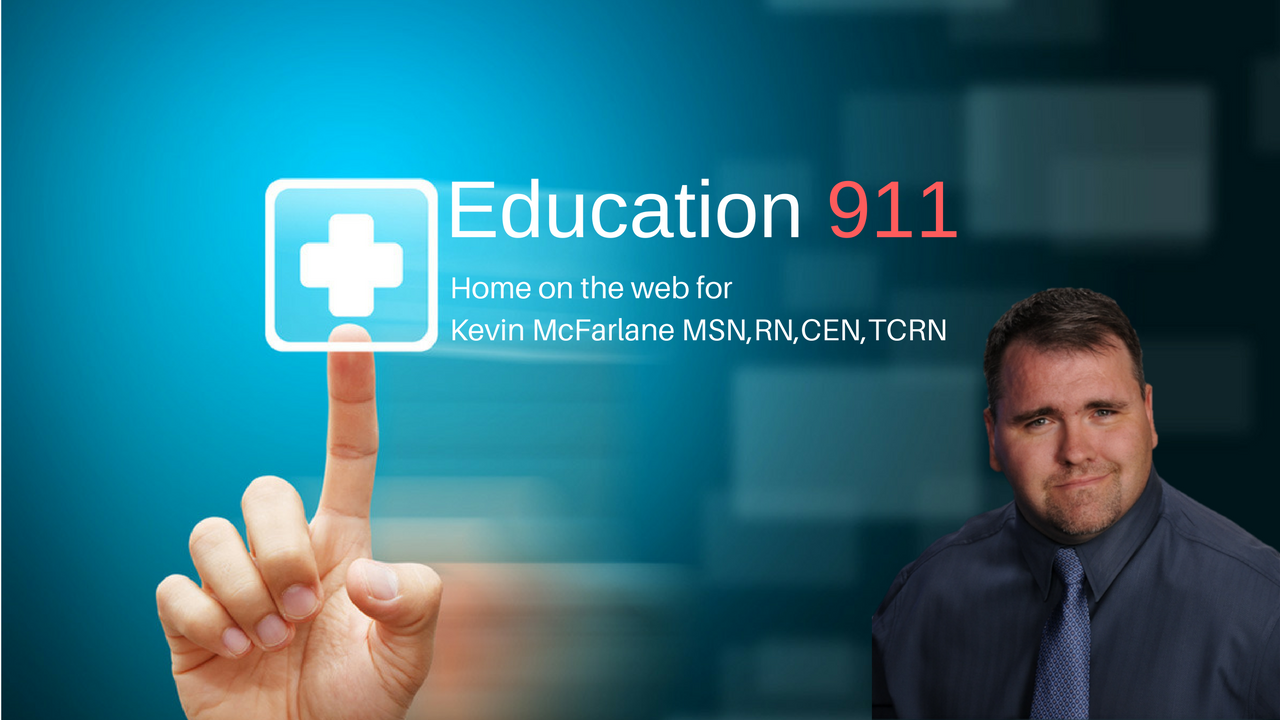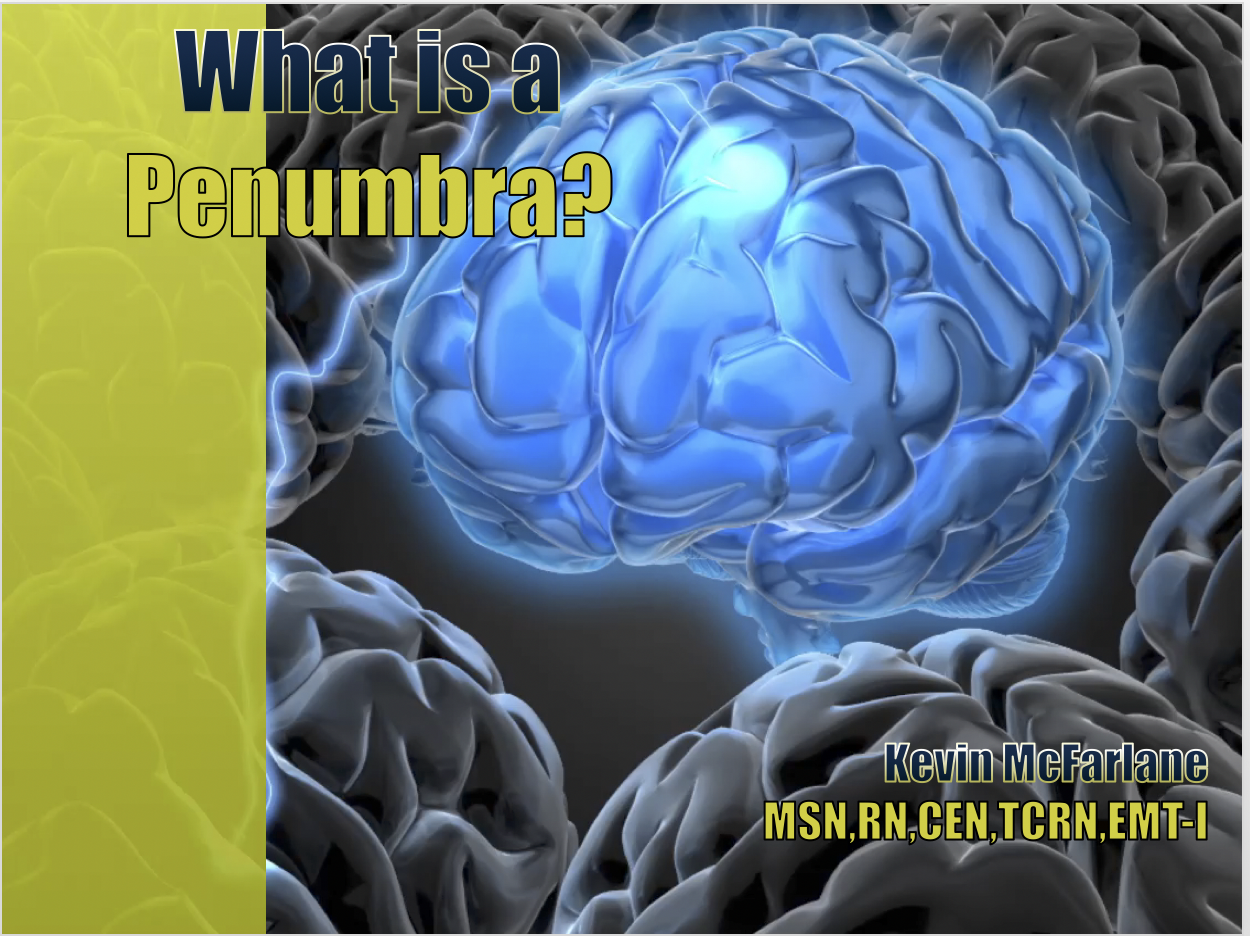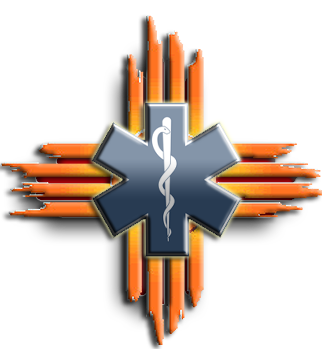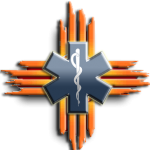

What is a Penumbra? Stroke Care 2016
Summary
You have just encountered a possible stroke patient. You ask yourself, what should I do first? How do I know it is a stroke? Is it too late to reverse the damage? How do I do the right things in the right order? This workshop will answer these critical questions. We will provide practical advice on the care of stroke patients in an acute setting. We will discuss designated stroke centers, and the latest technology in diagnosing and treating stroke patients.
Objectives
- Discuss the Signs and Symptoms of a stroke
- Discuss designated stroke centers
- Discuss diagnostic tests to identify stroke patients
- Discuss Treatment for stroke patients
- Answer the questions what is a penumbra

“Hold Still, You’re Going to Feel a Little Poke!” (60-90min)
Summary
This session will discuss the complicated task of pediatric venous access. Tips and tricks for starting pediatric IV’s will be discussed as well as pediatric intraosseous access. Broslow tape and other pediatric specialty devices will also be discussed.
Objectives
- List the two primary indications for pediatric I.V. administration in the field
- Explain how to select an I.V. catheter based on size and length.
- Describe the selection of a pediatric IV site
- Explain the differences in technique for starting a pediatric IV.
- Describe alternatives to peripheral venous access.
- Describe indication for intraosseous usage in pediatric patients
Welcome to They (60-90min)
Summary
You just received your first command or supervisory role, and suddenly you realize your perspective has to change. Many new managers struggle with the sudden change in roles. This session will make suggestions to help you survive long enough to make the difference you have always wanted “them or they” to make.
We will discuss practical tips to make your life easier and keep you from driving others nuts.
Management case studies, successes, and tragedies will be discussed in the hope of learning from the experience of others.
Objectives
- Describe effective communication techniques
- Explain the differences of a leadership role
- Discuss tips on personal productivity and organization


“So you’re the new guy “Precepting and Mentoring (60-90min)
Summary
This session will review the often-overlooked importance of clinical preceptors for both students and new employees. This session introduces the goals of a preceptor program, details the preceptors’ roles and responsibilities and the challenges inherent in precepting
Objectives
- Define the role of preceptors/mentors
- Define Preceptor’s relationship to students
- Describe the tools used for adult learning
- Discuss training principles / ideas
- Discuss importance of feedback in students growth and learning
- Identify communication styles and strategies for dealing with challenging interpersonal dynamics.
“Golden Years “Geriatric Care (60-90min)
Summary
This session will discuss the physiological and psychological changes that occur with aging. Communication and assessment techniques will also be discussed. Common geriatric emergencies and causes of trauma will be discussed
Objectives
- Review physiological changes that occur with aging
- Review psychological changes that occur with aging
- Review proper techniques for assessing geriatric patients
- Review common medical emergencies experienced by geriatric patients.
- Discuss pharmacologic concerns with geriatric patients.
- Review the common causes of falls in the elderly


“What’s wrong with you? Are you listening to me?” (60-90min)
Assessing and interviewing behavioral health patients
Behavioral emergencies present a challenge to EMS personnel because they are not always so clear-cut and the patients may be difficult. This session will assist the EMS Providers in exercising their most important behavioral health assessment tool, their communication skills. Interviewing techniques for manic, depressed and suicidal patients will be discussed
Objectives
- Recognize the importance of appropriate physical and verbal communication when caring for emergency patients.
- Understand how communication can significantly contribute to positive, or negative, patient responses.
- Learn to use specific communication techniques, words, and phrases to enhance positive patient responses to medical treatment.

“Birthing Emergencies: First Rule Stay Calm! (60-90min)
Summary:
The opportunities to handle birthing emergencies are rare in most busy EMS systems and can even be more so in rural systems. The rarity of births matched with the “mystery” of it leads to apprehension in EMS providers. Refreshing the process and stages of labor as well as the patient treatment will help you relax when the time comes. In most cases the presentation is normal and mom does all the work, we just catch.
Objectives
- Describe the changes of the expectant mother.
- Participants will be able to identify the stages of labor.
- Participants will describe how to handle the normal childbirth.
2 Dudes & 2 Beers– Alcohol and Minor Trauma (60-90min)
The session will look at the relationship between alcohol intoxication and minor traumatic injuries. We will discuss the importance of a careful history, physical exam, and the pitfalls of examination of the intoxicated patient.
Objectives
- Discuss alcohol’s role in traumatic injuries
- Identifying alcohol-related events in initial patient assessment using appropriate history, physical exam.
- Discuss identifying those at risk for serious injury
- Discuss the evidence for brief alcohol interventions effectiveness

Sorry, I Don’t Speak Pediatric (60-90min)
Summary
In this session, Kevin will give us a crash course in a foreign language so we will be able to communicate with our most frightening patients…. pediatrics. Communications do’s and don’ts will be covered, as well as age-related norms. Participants will learn to communicate at the level of the child of all ages.
Objectives
- Recognize the importance of age-related expectations when communicating with children.
- Understand how communication can significantly contribute to positive, or negative, patient responses.
- Learn to use specific communication techniques, words, and phrases by age group to enhance positive patient responses
How did I survive Childhood? (60-90min)
Summary
This fast-paced multimedia presentation is filled with examples of things we all probably did when we were kids. This presentation uses humor, and real life case studies to bring home the message of injury prevention to children of all ages. Methods of injury prevention from the playground to home and strategies for making it fun will also be discussed. Injury prevention is a primary concern for EMS providers. The easiest injuries to treat are the ones that were avoided in the first place. This presentation will provide a fresh and entertaining look at injury prevention.
Objectives
- The participant will be able to define injury prevention
- The participant will learn some of the common injuries of children between the ages
- Describe and define measurable changes in behavior for injury prevention outreach
- The participant will laugh, and wonder how did THEY survive childhood


Coming soon to a Town near you….drugs (60-90min) **JUST UPDATED**
Summary
In every city and even small town drugs are becoming more of a problem. Street Drugs pose a particular problem in today’s schools. It is now more important than ever for healthcare providers to have a working knowledge about street drugs. We will review common street drugs and give a little history and information about commonly used street drugs. The presentation will also present information from the national Youth Risk and Resiliency Survey that looks at the high risk behaviors of school-aged children.
Objectives
- Review of Common street drugs being used today
- learn to identify street names, paraphernalia
- Describe and define signs and symptoms of drug use
- The participant will be given resources for staying up to date on the drugs kids are using in your town
“Pimp My PowerPoint”
Summary
Are your presentations old and busted? PowerPoint is an amazing tool that can organize course material making it easy to present. Many EMS educators using PowerPoint to deliver presentations, yet few do it ways that will help deliver the education. This session will start from slide one and walk you through building an effective PowerPoint presentation. We will discuss some commonly ignored rules for PowerPoint, and also discuss how and when to break the rules.
This session will teach participants how to use PowerPoint to make presentations more fun, stimulating, interesting and even inspiring. We will discuss the effective use of pictures, audio, and video clips. This class will give tips you can use immediately to make your presentations better. Participants are encouraged to bring a laptop, a favorite presentation or a work in progress, and thumb drive.
Objectives:
- Review the “rules” of PowerPoint
- Understand the power of visuals
- Review common problems of PowerPoint
- To stamp out bad PowerPoint presentations
This Session can be done in two ways:
- Presentation setting with unlimited participants
- Hands on workshop*
*The hands-on workshop will allow participants to bring a laptop and work on a presentation during the session. Workshop format requires a limit of 20 participants.

They take two friends with them
Summary
Dealing with death is not only difficult for the family members and friend but also takes a toll of health care providers. Family members are often filled with a wide range of reactions that are part of the process. Health care professional sometimes also need to cope with our own grief and stress. This presentation will describe the grieving process. We will also discuss some of the cultural differences that affect reactions to death and tragedy.
Objectives
- Discuss the five stages of the grieving process.
- Discuss how to enhance emotional support in situations that involve sudden unexpected death.
- Describe the common needs of the patients, family, and staff when dealing with death and dying.
- Discuss how cultural attitudes and personal beliefs effect reactions to death.
Stroke Research for Dummies (60-90min)
Summary
Stroke remains the third leading cause of death and the leading cause of disability on the US. This session will take a look at what we know about stroke and what the latest research and science may have around the corner. Kevin will break down and simplify some of the latest in stroke research and trials. Participants will come away with a renewed hope and great information to share with their colleagues.
Objectives
- Discuss common themes in stroke research
- Discuss the major stroke trial recently finished, and currently under way and potential implications
- Discuss the process from research to adoption into practice.


Teen Suicide (60-90min)
Summary
The session will provide an understanding of the suicidal teen including early warning signs, lethality evaluation, immediate crisis intervention and long-range deterrents. We will discuss the importance of teens understanding basic intervention strategies that disrupt suicidal ideation.
Objectives
- Identify the myths and facts about teen suicide
- Identify the causes of teen suicidal behavior
- Describe the risk factors for suicide using SADPERSONS
- Identify the suicide intervention strategies for health care providers and the public
Trauma Care: The Right Place at the Right Time (60-90min)
Summary
Trauma care requires rapid assessment and decision- making in the field. This session will take you through the proper decision-making process for your trauma patients. We will review what truly constitutes a trauma center, appropriate field trauma triage criteria you should follow and limited field interventions recognized as the most beneficial for severely traumatized patients.
Objectives
- Define what Trauma is
- List the components of a comprehensive trauma system
- Discuss the importance of appropriate trauma triage

Baby Zebras: Unusual Pediatric Medical Cases (60-90min)
Summary
We often tell no EMS providers when they hear hoof beats to look for horses not zebras, but those zebra cases are still out there. In this session, we will discuss unusual pediatric emergencies through case studies. This session will remind you that zebras do exist and sometimes show up in your ambulance
Objective
- Describe the importance of the pediatric assessment
- Describe the process of differential diagnosis
- Participants will be able to identify a zebra


Not from the Heart: Non-Cardiac Chest Pain (60-90min)
Summary
Advanced Life Support has a primary goal of treating acute cardiac emergencies. Let’s not forget there are other important and dangerous causes of chest pain that are not from the heart. This discussion reviews those causes and outlines the differences between those presentations (signs and symptoms) and the presentation of patients with acute coronary syndromes.
Objectives
- Review essential triage assessment questions
- Describe possible causes of non-cardiac chest pain
- Differentiate clinical presentations of cardiac and non cardiac patients
Dealing with Difficult People: When Leaving Them Isn’t an Option (60-90min)
Summary
Dealing with difficult people is a fact of life. In emergency situations, it only gets worse. Difficult people can be patients, families, coworkers, and even your superiors. This session will give you the tools you need to be more effective with conflict and defuse difficult situations.
Objectives
- Learn to recognize a conflict as it arises.
- Understand one’s own conflict resolution style.
- Demonstrate an understanding of conflict resolution strategies.
- Discuss the psychological needs of the patients and families and even yourself.


Social Media: Thanks for Sharing (60-90min)
Summary
In this presentation, we will discuss the pros and cons of broadcasting your life of the world to see. Thanks to the web 2.0 our online habits have changed from closed private activity to one we share with all our friends and with the world. In this session Kevin will discuss the changes in online behaviors, and what professionals young and old should do to help protect not only their reputations but the reputation of the industry as a whole.
Objectives
- Discuss the dangers of sharing your world
- Describe way to protect your professional reputation
- Discuss ways to clean up your digital image
A Scream for Help: Understanding Self-Injury (60-90min)
Summary
Young people are cutting and burning their arms, wrists, legs, and stomachs today more than ever before. The behavior is defined as the deliberate, repetitive, impulsive, non-lethal harming of one’s self. In this presentation, we will discuss common presentations and needed psychological interventions.
Objectives
- What exactly self-injury is and is not
- How self-injury differs from suicide
- The most common ways individuals hurt themselves

That’s Gonna leave a mark: Sports related injuries (60-90min)
Summary
This session will discuss sports-related injuries, with emphasis on head, neck and, extremity injuries. Common mechanisms of injury, potential injuries associated with various sports will be discussed. Not only will we discuss handling the child but the parents as well.
Objectives
- Discuss the pediatric trauma.
- Discuss common injuries in many sports.
- Discuss communicating with kids and parents.
- Discuss pain control.
Patient Assessment: Thinking Outside the Box. (60-90min)
Summary
The ability to perform an accurate patient assessment is one of the most important skills for the EMT. The information gained during the assessment is used to make decisions regarding emergency interventions, such as the need for immediate airway or circulatory management. Since this information is used in clinical decision-making, it is important that the assessment findings are interpreted correctly and efficiently. This session will offer a variety of clinical insights intended to clarify and reinforce the assessment skills the EMS providers already use.
Objectives
- Review the patient history process.
- Review the basic patient assessment.
- Review the common landmines in patient assessment.

Apparent Life-Threatening Events in Infants (ALTE) (60-90min)
Summary
We have all seen an infant that, at the time of examination, appears well but whom the caregiver reports as “stopped breathing,” or “turned blue.” In these cases. consideration should be given to a potential Apparent Life-Threatening Event (ALTE). The cause of the ALTE can be any number of neurologic, heart, lung or endocrine problems. In this session, we will review how to recognize ALTE and importance of maintaining a high index of suspicion when confronted with such a case.
Objectives
- Define ALTE
- Discuss ALTE versus SIDS\
- Discuss the importance of a comprehensive history and assessment
When Little Ones Get Big Boo-Boos: Pediatric Trauma (60-90min)
Summary
We’ve always been reminded that pediatrics patients are not “little adults”, this is especially true when dealing with critically injured patient. In this session we will review developmental differences of kids, and focus on the major body systems to see why injured kids can get in trouble fast. This session reviews assessment and management of pediatric trauma.
Objectives
- Review the anatomical differences in pediatric patients
- Explain unique characteristics related to pediatric trauma care
- Describe management considerations for the pediatric trauma patient


The Lies Hollywood Told Me (60-90min)
Summary:
Do your friends and family refuse to watch TV with you? Are you the person in the theater that says, “No, that’s not true” Well, this session is here to let you know that you are not alone. Health care providers all over the country are being banned from watching top television shows like: House, ER, and Greys Anatomy. In this session, we will explore the phenomenon of medical care as Hollywood fodder. We will discuss what the public knows about emergency care and what they think they know. This session will use actual clips of top television shows and movies to illustrate what the public’s perception of emergency care is based on. This is a fun, enlightening, and sometimes hilarious session we will discuss the truth and lies that the public learns about medicine from the small and silver screen.
Objectives
- Review common medical myths people see on TV.
- Discuss the challenges involved with a partially educated public.
- Review and laugh at “Hollywood medicine” and at ourselves.
The TRICs of Trauma (60-90min)
ObsteTRICS, PediaTRICS, and GeriaTRICS patient present a special challenge when they experience trauma. In this session, we will discuss the emergency care of injured children, obstetric patients, and geriatric patients. We will discuss key differences in anatomy and physiology for each population as well as how to adjust your care to meet their specific needs.
Objectives
- Prioritize assessment needs for the Obstetric, Pediatric, and Geriatric patients who experience trauma.
- Identify physiologic and anatomic changes in pregnancy that affect the trauma assessment.
- Explain unique characteristics related to pediatric trauma care
- Identify unique the changes and characteristics of the geriatric patient in relation to trauma care.


How to deal with a DIVA (60-90min)
Starting a peripheral intravenous (I.V.) line in your truly sick patients can be difficult, to say the least. Today, many of these patients are old and young, malnourished, and dehydrated. In this session, we will review how to deal with a D.I.V.A. Difficult I.V. Access. We will review how to increase your odds of success, and also discuss alternatives of IV access. Come share your tips and leave with a few more trick you may not have known.
Objectives
- Identify how to tell if someone is going to be a D.I.V.A.
- Describe three tips for increased IV success
- Describe two IV alternatives for fluid resuscitation
Identifying and Avoiding a Respiratory Death (60-90min)
Summary
Mosby’s medical dictionary defines respiratory failure as ‘the inability of cardiac and pulmonary systems to maintain an adequate exchange of oxygen and carbon dioxide in the lungs’. Many pathologies can cause respiratory failure, but failure is a problem of either oxygenation or ventilation. In this session we will discuss the signs and symptoms of impending respiratory failure, and how both the BLS and ALS providers can intervene before it is too late.
Objectives
- Discuss common respiratory emergencies
- Discuss Signs of pending respiratory arrest
- Discuss respiratory interventions for both the BLS/ALS providers


You Mad Bro? Dealing With and Defusing Aggressive Behavior (60-90 minutes)
Summary
This session teaches proven crisis negotiation techniques to assist health care providers in managing aggressive behavior. The class will cover identification of pending aggression and well as verbal de-escalation tactics designed to keep EMS providers safe. We will also discuss the impact and implications of physical and chemical restraints.
Objectives
- Identifying and prevent aggressive behavior
- Discuss verbal and nonverbal communication
- Demonstrate active listening
- Discuss the implications of physical and chemical restraints

The Mile High Club (60-90min)
Summary
Have you been there? On the plane, flying over wherever, and over the airliner’s public address system heard the call go out for medical assistance? What do you do? What can you do if you respond? This lecture will take a look at some of the issues you will face if you choose to be a Good Samaritan while flying.
Objectives
- Review the risks and benefits of responding to an aircraft emergency
- Review common in air emergencies
- Review equipment that may be available to you as a responder
Baby Can’t Breathe: Pediatric respiratory emergencies (60-90min)
Summary
In the pediatric population, respiratory emergencies are not uncommon. In this session, we will review common pediatric respiratory problems ranging from mild to critical. We will discuss anatomy differences and how these may affect your treatments. Multiple case studies will highlight assessment, differentiation, and treatment of the most common respiratory emergencies.
Objectives
- Discuss common pediatric respiratory emergencies
- Discuss signs of different respiratory emergencies arrest
- Discuss pediatric respiratory interventions for both the BLS/ALS providers
Situational Awareness (60-90min)
Summary
Unlike most professions EMS works in every environment and each day face a multitude of inherent risks to themselves, their patients and the public.
While the risk of emotional stress, physical violence, and serious harm or even death is very real; there are simple steps the EMS can take to keep themselves and others safe. This interactive presentation will discuss potential scene hazards and emphasize situational awareness to keep providers safe. We will discuss how you can effectively respond to potentially dangerous situations both before and after you have entered the scene. The session will use proven tactics to maximize the providers’ personal safety and help make sure everyone goes home at the end of the shift!
Objectives
- Identify dangerous situations where EMS may deliver care
- Discuss warning signs of potential danger
- Discuss how EMS providers can maintain a safe care environment
Bag Full of Goodies: Your Patients Medications (60-90 minutes)
Summary
EMS providers are all too familiar with the paper bag full of medications that the patient presents during their care. Patients often times do not know what the medications are for or why they are prescribed. A patient’s medications can provide critical information regarding the patient’s underlying conditions and medical history. In the session, we will review commonly prescribed medication and discuss what each tells you about the patient. Case studies will be used to help us solve the patient history puzzle.
Objectives
Identifying the most commonly prescribed medication
Discuss history based on medications
Discuss the problem of polypharmacy in elderly patients.
Book me for your next event. Fill out the information below to start the discussion

I look forward to speaking with you.
